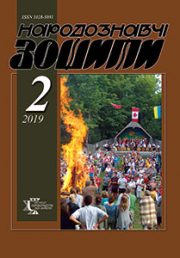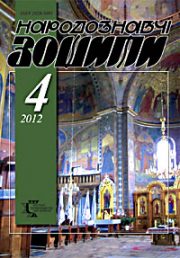The Ethnology Notebooks. 2022. № 6 (168), 1272—1290
UDK 39(477.86/.87+477.83=161.2):[644.11:697.2]”18/19″
DOI https://doi.org/10.15407/nz2022.06.1272
RADOVYCH Roman
- ORCID ID: http://orcid.org/0000-0002-1900-8948
- Doctor of Sciences in History, Senior Researcher
- of the Institute of Ethnology
- of the National Academy of Sciences of Ukraine,
- in the Department of Historical Ethnology,
- Svobody Avenue 15, 79000, Lviv, Ukraine,
- Contacts: e-mail: radovychroman@gmail.com
Abstract. Ethnologists, studying traditional housing, primarily distinguish horizontal planning and the heating system, among a number of typological features. Therefore, the research of the heating system, its individual components in general in Ukraine and in its individual ethnographic regions is extremely relevant.
The heating system of a traditional home includes heating devices (open hearth, stove, oven («hrubka»), kitchen stove, etc.) and devices for smoke removal (chimneys-smoke collectors, chimneys, chimneys-outputs, etc.). The main heating device in the homes of the fighters was a stove. In the proposed investigation, the author sets himself the goal of finding out the features of this heating device (characterizing building materials, structural features, techniques and technology of its construction).
The object of the study is traditional construction, and the subject is the heating system (actually, the main heating device the stove).
The methodological basis of the research is the principle of historicism in combination with elements of structural and functional analysis and the use of the main methods of ethnological science: retrospective, typological, complex and analysis, historical reconstruction, etc.
The territory of the study covers the entire territory of Boikivshchyna. Chronological boundaries of the study: 19th the first half of the 20th century.
The stove in Boikivschyna, like everywhere else in Ukraine, was placed indoors near the entrance, in the corner, between the back and passage walls of the house. The oven hole was turned towards the long front wall. The furnace chamber — the main working part of the traditional stove — was located on a quadrangular platform, raised above the firebox — «opichchia». «Prypichok» were arranged in front of the oven hole, and «zapichok» were arranged on the side of the vault. During the construction of the furnace, various building materials were used: clay, stones, raw or burnt bricks, etc.
Keywords: Heating system, stove, furnace chamber, «opichchia», «cherin», «prypichok», «zapichok».
Received 14.11.2022
REFERENCES
- Siletskyi, R. (2001). The problem of typology of heating devices of ancient dwellings in Ukraine (constructive and functional features of the furnace). Notes of NTSH (pp. 230—247) [in Ukrainian].
- Makarchuk, S. (2012). Historical and ethnographic regions of Ukraine: teaching. manual [in Ukrainian].
- Hlushko, M. (2013) Pidhiria — a separate ethnographic unit of Ukraine? Bulletin of Lviv University: Historical series (Issue 48, pp. 299—318) [in Ukrainian].
- Zubrytskyi, M. (2013). Peasant houses in Mshanets, Starosambir district. In Zubrytskyi M. Collected works and materials in three volumes. (Vol. I, pp. 477–493) [in Ukrainian].
- Zubrytskyi, M. (2013). The village of Kindrativ (Turka district) In Zubrytskyi M. Collected works and materials in three volumes. (Vol. I, pp. 95—116) [in Ukrainian].
- Kobilnyk, V. (1936). Material culture of the village of Zhukotyna, Turchan district. (Excerpt from «Chronicles of Boikivshchyna», ch. 7—9) [in Ukrainian].
- Kishchuk, T.P. (1983). Interior of a dwelling. Boikivshchyna: historical and ethnographic research [in Ukrainian].
- Danyliuk, A. (2004). Folk architecture of Boikivshchyna. Housing [in Ukrainian].
- Radovych, R. (2017). Polissya dweling: cultural and genetic origins and evolutionary processes. Lviv [in Ukrainian].
- Blomkvist E.E. (1956). Peasant buildings of Russians, Ukrainians and Belorussians: (settlements, dwellings and economic structures) In East Slavic ethnographic collection: Essays on folk material culture of Russians, Ukrainians and Belarusians in the 19 — early 20 centuries (pp. 3—458). Moscow: Publishing House of the Academy of Sciences of the USSR [in Russian].
- Siletskyi, R. (1999). The heating system of the folk dwelling of the polishchuky (types of heating devices, their design features, customs and beliefs). Polissia of Ukraine: materials of historical and ethnographic research (Vol. 2, pp. 125—140 [in Ukrainian].
- Vovk, Hv.(1995). Ethnographic features of the Ukrainian people. In Vovk, Hv. Studies on Ukrainian ethnography and anthropology (pp. 39—218). Kiev: Art [in Ukrainian].
- Rappoport, P.A. (1975). Old Russian dwelling. Archeology of the USSR: AIS (Issue E 1–32.). Leningrad: Science [in Russian].
- Kotsan, V. (2018). Memories and information from the Verkhovyna village of Bukovets, Volovets district, Transcarpathian region: manuscript written and edited in 1960—1968 by M.I. Parlag. Scientific collection of the Transcarpathian Museum of Folk Architecture and Life. Issue 5, pp. 240—280 [in Ukrainian].
- Rainfus, R. (2020). Materials for the study of Boikos` material culture [in Ukrainian].
- Archive of the Museum of Folk Architecture and Life in Lviv (hereinafter — Archive NMFALL). F. Materials of expeditions, ref.ЗВ -15, 22 sheets [in Ukrainian].
- Syvak, V. (2017). General characteristics of the interior of the national dwelling of the Carpathian Ukrainians of the end of the 19th — the first half of the 20th century (common features, local specificity, dynamics of development). The Ethnology Notebooks, 6, 1281—1306 [in Ukrainian].
- Ethnographic image of modern Ukraine. Corpus of expeditionary folklore and ethnographic materials. (2020). T. 9. People’s housing culture. Ecology and organization of habitat [in Ukrainian].
- Falkowski, J. (1937). Zachodnie pogranicze Huculszczyzny: Dolinami Prutu, Bystrycy Nadwornianskiej, Bystrycy Soljtwinskiej i Lomnicy [in Polish].
- Archive NMFALL. F. Materials of expeditions, ref. ЗВ -57, 15 sheets [in Ukrainian].
- Archive NMFALL. F. Materials of expeditions, ref.ЗВ -93, 18 sheets [in Ukrainian].
- Franko, I. (1985). My paternal house. Franko I. Collected works: in 50 volumes. Volume 39, pp. 243—244 [in Ukrainian].
- Sopolyha, M. (2016). Folk architecture of Ukrainians in Slovakia [in Ukrainian].
- Radovych, R. (2015). National architecture Staryi Sambir district in the nineteenth — first half of the twentienth century (housing and economic complex) [in Ukrainian].
- Moszynski, K. (1929). Kultura ludowa slowian. Cz. 1: Kultura materjalna [in Polish].
- Lysenko, P. F. (1985). Berestie [in Russian].
- Mykhailyna, L.P. (2007). Slavs of the VIII—X centuries between the Dnieper and the Carpathians [in Ukrainian].
- Haiova, E. (2019). Peculiarities of the revival of the material culture of Velykyi Bereznyi district in the «Carpathian» exposition of the National Museum of Folk Architecture and Life of Ukraine. Scientific collection of the Transcarpathian Museum of Folk Architecture and Life (Issue 6, pp. 147—165) [in Ukrainian].
- Simonenko, I. F. (1948). Life of the population of Zakarpattia region. Soviet ethnography, 1, 69—74 [in Russian].
- Hoshko, Y.G. (1976). The population of the Ukrainian Carpathians of the 15th-18th centuries. Settlement. Migration Everyday life. Kiev: Scientific Opinion [in Ukrainian].
- Prykhodko, N.P. (1975). Some issues of the history of housing in Ukraine. The ancient dwelling of the peoples of Eastern Europe (Pp. 245—275) [in Russian].
- Hlushko, M. (2017). Little-known study of Marko Hrushevskyi. The Ethnology Notebooks, 3, pp. 531—540 [in Ukrainian].
- Hrushevskyi, M. (2002). From the life of peasants in the Chihyryn region. Sights of Ukraine: history and culture, 2, 127—135 [in Ukrainian].
- Symonenko, I.F. (1949). Materials for the history of the oven in the territory of Ukraine. Brief reports of the Institute of Ethnography of the Academy of Sciences of the USSR (Vol. 8, pp. 10—18) [in Russian].






